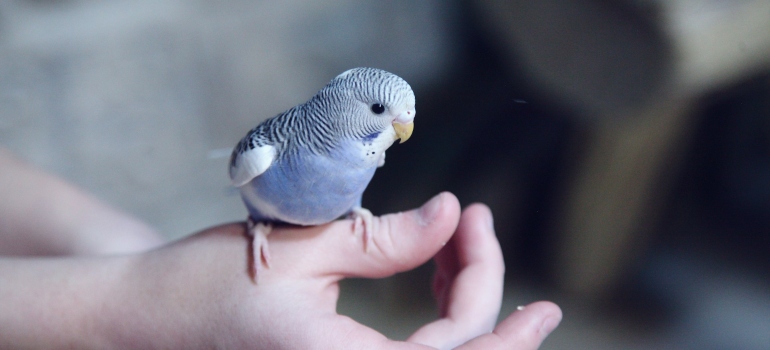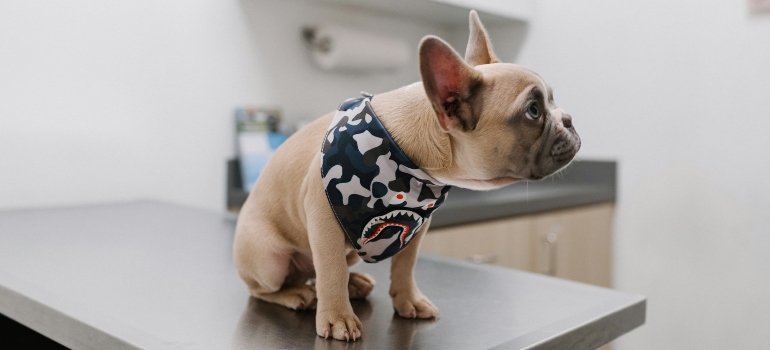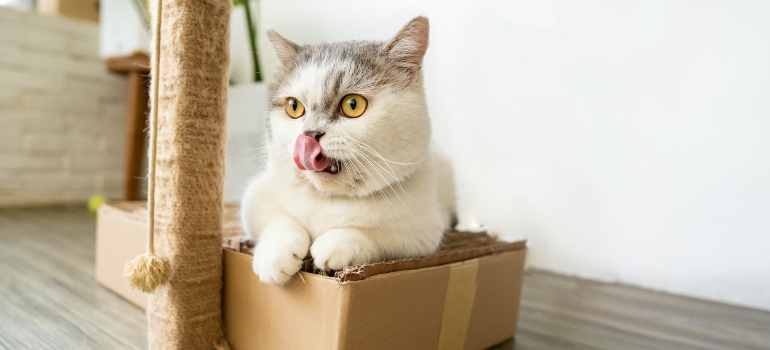Long-distance Move With Your Pet – How to Organize It?
Moving to a new home is a significant event in anyone’s life, but the stakes are even higher when pets are involved. As pets often feel like members of the family, ensuring their comfort and safety during a move is paramount. This guide by a moving company Seattle residents trust will provide essential tips and strategies for organizing a long-distance move with your pet. Ready to ‘paws’ the stress and make your move a ‘furr-tastic’ success?
Long-Distance Moves and Their Impact on Different Pet Species
Have you wondered what is considered a long-distance move and how it affects pets of different species? When we talk about a long-distance move, it typically refers to a relocation that spans several hundred miles, often crossing state lines or even moving from one coast to another. The distance and time involved in such moves can significantly affect your pet, and the impact can vary greatly depending on the species.
- Dogs are generally adaptable but can feel anxiety due to changes in routine and environment. The physical and mental stimulation from a long car journey or an airplane ride can be tiring and stressful. Ensuring frequent breaks, maintaining a sense of normalcy, and providing reassurance are key to helping your dog cope.
- Cats are territorial and often find moves more stressful than dogs. The long confinement during travel and the introduction to a new environment can cause anxiety. It’s crucial to keep them secure in a carrier and allow them to acclimate to their new surroundings at their own pace gradually.
- Birds are sensitive to changes in their environment and can be stressed by long trips. They require a stable and quiet setting to avoid stress during the move. Ensure their cage is secure and covered during transport to provide a sense of security.
- Small mammals like rabbits and guinea pigs can also find the moving process unsettling. These animals require a quiet and calm travel environment as they are prone to stress. Keep their regular bedding and a few familiar objects with them during the move to help soothe them.
All pets need to maintain a consistent routine as much as possible during the long-distance move from Seattle. The more you can mimic their usual schedule and provide familiar items, the easier it will be for them to adjust. Understanding the specific needs of your pet’s species and planning accordingly can mitigate the effects of a long-distance move, ensuring a smoother transition for your beloved companion.

How to Plan a Move With Pets Over Long Distances?
Planning a long-distance move demands careful consideration of your pet’s comfort and safety. Since pets often experience anxiety with changes in their environment, thorough preparation is essential. Furthermore, a well-structured long distance move checklist offers a clear roadmap, effectively mitigating potential stressors for your furry companions.
Pre-Move Preparation:
- Acclimate your pet to the pet carrier.
- Gradually introduce your pet to moving boxes and new arrangements.
- Arrange for veterinary visits and obtain necessary records.
Moving Day:
- Ensure your pet is in a safe, quiet place away from the moving chaos.
- Use a professional pet sitter or trusted friend to watch over your pet.
Travel and Arrival:
- Plan for regular breaks and maintain a calm environment.
- Keep your pet secured and comfortable during travel.
- Upon arrival, gradually introduce your pet to the new home.
Post-Move Adjustment:
- Re-establish a routine to help your pet adjust.
- Monitor your pet’s adjustment and consult a vet if behavior issues persist.
Additionally, considering every aspect of your pet’s experience—from pre-move adjustments to post-move acclimation—ensures a smoother relocation. Ultimately, thoughtful planning is crucial to address pets’ unique challenges when you’re moving interstate from Washington, highlighting the importance of a checklist in maintaining their well-being throughout the process.
Preparing Your Pet for the Move
When planning a long-distance move, it’s essential to carefully prepare your pet to ensure they remain calm and comfortable. This stage involves several crucial steps that can significantly ease the transition for your animal companion.
Introduction to the Pet Carrier
Long-distance moves often require transporting your pet in a carrier. To help your pet acclimate, introduce the carrier well in advance of your move. Set it up as a comfortable resting place in your home, perhaps with treats or favorite toys inside. This can ease your pet’s anxiety and make the carrier a familiar, safe space.
Familiarization with Moving Boxes
The appearance of boxes and moving supplies can be stressful for pets. Introduce these items gradually so your pet can get accustomed to the new sights and sounds without panic. If you anticipate a lot of activity, such as from a packing services Seattle offers, consider arranging a quiet, comfortable space away from the chaos to keep your pet calm.

Gradual Adjustment to New Routines
As the moving day approaches, try to adjust your pet’s daily routines gradually to align with what will be expected after the move. This might include slightly shifting feeding and walking times. Such adjustments can help your pet adapt more quickly to the new environment once you’ve relocated, reducing overall stress.
Key Considerations for a Smooth Transition
When moving with pets, choosing the right services and preparing properly are critical to ensure their safety and well-being. Here are some vital steps to consider for a stress-free move.
Choosing the Right Moving Service
When planning a long-distance move with your pet, selecting moving services in Seattle that align with your needs is crucial, even though they might not handle pet moving services directly. It’s important to work with a mover who understands the unique considerations of relocating with pets and can accommodate the overall atmosphere of your move to be as stress-free as possible.
Since handling your pet’s move personally often results in less stress for both you and your animal, look for a moving company that supports your role in this aspect. They should be flexible and willing to coordinate around your schedule, especially when you’re tending to your pet’s needs during the move.
Ensure that the moving team is aware that you will be managing your pet’s relocation yourself. The awareness helps them maintain a suitable environment during the moving process, such as quieter operations or more predictable schedules, which can help keep your pet calm and secure. Choosing a company that respects and facilitates your involvement in your pet’s care during the transition is key to a successful move.
Hiring a Pet-Sitter for Moving Day
Moving day can be particularly chaotic, which is stressful for pets. Consider hiring a pet sitter or asking a reliable friend to look after them to keep them calm and safe. They will shield them from the confusion and noise associated with moving, such as the coming and going of movers and the disturbance of packing. A familiar face can provide reassurance and stability on this hectic day.
Veterinary Care and Records
Well before your move, schedule a visit to your veterinarian. Ensure all vaccinations are up-to-date and secure copies of your pet’s medical records. Apart from updating records at your new location, you must comply with interstate travel regulations if applicable. It’s also a good opportunity to discuss sedation if your pet is particularly prone to anxiety during travel.

Ensuring Safety and Comfort During the Move
Ensuring your pet’s safety and comfort during a long-distance move is vital. Here’s how to move with pets safely and comfortably and make the journey smoother for both of you.
Travel Arrangements
Careful travel route planning is essential for a long-distance move with your pet. If you’re driving, map out your journey, considering the need for frequent stops. These breaks are crucial for allowing your pet to stretch, hydrate, and relieve themselves. Along with the practicalities of travel, comfort is key.
Environment Control in Vehicle
If you’re traveling by car, maintain a controlled environment. Ensure the vehicle is well-ventilated and the temperature is consistent and comfortable. Avoid extreme temperatures by using air conditioning or heating as necessary. Also, ensure that your pet’s travel area is secure and safe, preventing any loose movement that could cause injury.
Familiar Scents
Bring a familiar blanket or toy to comfort your pet and provide a sense of familiarity in the changing environment. In addition, consider incorporating other familiar scents into your pet’s travel space. Items like a piece of your clothing can be soothing for pets, as they carry a scent they recognize and associate with safety.
Customized Pet Travel Kit
Prepare a travel kit specifically for your pet, including water, food, a bowl, a leash, waste bags, grooming supplies, and any medications they need. Having these items easily accessible will make the journey smoother and more comfortable for your pet.
Identification and Documentation
Ensure your pet has proper identification, such as a collar with an ID tag that includes your current contact information. It’s also wise to carry a recent photo of your pet and any required travel documentation, such as proof of vaccinations or health certificates, especially if you’re crossing state lines.
Monitoring Your Pet’s Behavior
Closely monitoring your pet’s behavior and health is vital throughout the move. Pay attention to changes in their appetite, behavior, or energy levels, as these can be stress indicators. Maintaining patience is crucial; remember that pets can pick up on your emotional state. Regular, calm interactions and frequent check-ins can reassure your pet and help maintain their well-being during this disruptive time.
Settling in After a Long-distance Move With Your Pet
Moving to a new home and unpacking your Seattle moving boxes can be just as disorienting for pets as it is for humans. It’s crucial to help your pet adjust to their new environment with patience and careful planning. Here’s how you can help them settle in smoothly.
Establishing a Routine
Pets thrive on predictability, and a consistent schedule offers comfort and a sense of security. As soon as you move in, set up their feeding, walking, and playtime schedules to mirror those they were accustomed to before the move. Besides, consistency helps minimize the stress associated with their new surroundings. If possible, also try to maintain the same brand of food and treats initially to avoid gastrointestinal issues that can arise from sudden changes in diet.
Exploring the New Environment
When introducing your pet to their new home, it’s best to do it gradually. Start by allowing them to adjust to one area or room where they can find their essentials like food, water, and toys. Once they seem comfortable, you can gradually introduce them to other areas of the house. This method helps prevent overwhelming them with too much new space all at once.

Creating Safe Spaces
Identify and create a specific spot where your pet can feel safe and secure—a “safe haven” they can retreat to when they feel stressed. This could be a quiet corner with their bed and a few favorite items. Having a designated safe space can significantly help ease their anxiety during the transition period.
Positive Reinforcement
Use plenty of positive reinforcement as your pet adjusts. Treats, cuddles, and verbal praises can help associate the new environment with positive experiences. Encourage and reward your pet for exploring their new surroundings and settling down. This can aid in quicker adaptation and a more positive outlook on their new home.
Patience and Monitoring
Finally, keep in mind that each pet adjusts at their own pace. Monitor their behavior closely during the first few weeks. Look for signs of stress or anxiety, such as hiding more than usual, vocalizing excessively, or changes in eating habits. If these issues persist, consider consulting with a veterinarian or a pet behaviorist for additional support.
Pawsitive Endings Bring Smooth New Beginnings
As you close the chapter on your old home and begin a new adventure, remember that this challenging transition can also be a time of bonding and new discoveries for you and your pet. Remember, you’re not the only one trying to cope with moving stress. Take the time to plan and execute each step of your move carefully so you can lay a solid foundation for your pet to thrive in their new environment.
Your attentiveness and care ensure that your pet will adjust quickly and comfortably, making your new house feel like home. And finally, welcome the fresh start a long-distance move with your pet brings with optimism. Watch as your pet discovers new corners to explore and new places to relax, each tail wag and purr a sign that they are settling in!
Why Choose Us
History
Hansen Bros. Moving & Storage is locally owned and operated by the same family for four generations, since 1890. We have a well-established reputation for service quality and reliability with a high percentage of repeat household and commercial clients.
Professionalism
We’re a certified ProMover by the American Moving and Storage Association with A+ rating with the Better Business Bureau, voted “Best in Western Washington” in 2009 and from 2011 to 2016 by KING5. Our company is fully licensed and insured and member of WMC and AMSA.
Value
Hansen Bros. Moving & Storage provide free, no-obligation in-home estimate and competitive rates, including low minimum rates for shipments moving under 300 miles. We’ve set a refund policy for unused packing materials and three Puget Sound locations to help clients save on travel fee costs.



